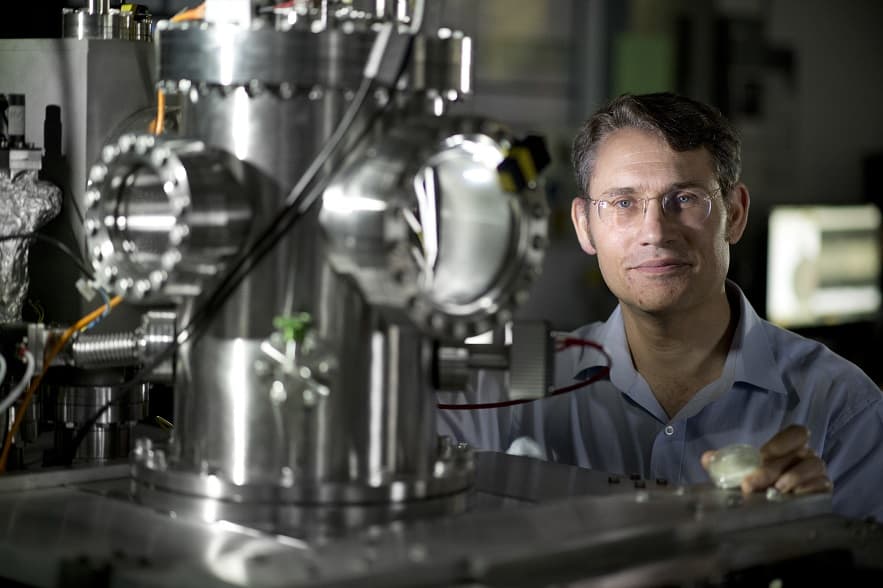World’s First Scanning Helium Microscope Can Observe A Honey Bee's Eye Without Frying It
A team of researchers at University of Newcastle, led by Professor Paul Dastoor, has developed the world’s first 'Scanning Helium Microscope'. Current high powered microscopes either use light or electrons which are projected in a beam at the specimen under observation, which note the change of signals caused when the electrons/light interact with the specimen converting it into an image. However, as the specimen under observation are at a minuscule scale, they can be affected due to the projected light.
According to the scientists the current way of observing biological samples is considered a paradox as the very process of observation using the current microscopes changes or modifies the state of the sample that is being studied. To eradicate this paradox, the Scanning Helium Microscope (SHeM), uses a beam of helium atoms which is projected at the specimen.

The helium atom is a preferred option due to its rare quality of being chemically, electrically and magnetically inert. The inertness prevents the helium atom to change any aspect on the specimen under observation, unlike electrons or light which at times can even destroy the specimen.
Another great use for the SHeM is that it can be used to observe electronic circuits while they are under operation as unlike the electron microscope, the helium atom will not cause any change/damage to the flow of electrons within the circuit. It is also the only microscope that can be used to study organic specimen without altering/modifying their natural state like the eye of a honey bee or the wing of a butterfly.
 Building the SHeM was Professor Dastoor’s dream since he was a PhD student at Cambridge studying helium atom scattering and it took him 20 years to build the current version. The first prototype was built 2011 in just 7 weeks which has since been refined at University of Newcastle. The next goal for the team is to build a smaller version of SHeM so it can be used in many other universities worldwide. This, according to Professor Dastoor, will open a new window for the researchers in the world of science.
Building the SHeM was Professor Dastoor’s dream since he was a PhD student at Cambridge studying helium atom scattering and it took him 20 years to build the current version. The first prototype was built 2011 in just 7 weeks which has since been refined at University of Newcastle. The next goal for the team is to build a smaller version of SHeM so it can be used in many other universities worldwide. This, according to Professor Dastoor, will open a new window for the researchers in the world of science.
Source: #-Link-Snipped-# | #-Link-Snipped-#
According to the scientists the current way of observing biological samples is considered a paradox as the very process of observation using the current microscopes changes or modifies the state of the sample that is being studied. To eradicate this paradox, the Scanning Helium Microscope (SHeM), uses a beam of helium atoms which is projected at the specimen.

The helium atom is a preferred option due to its rare quality of being chemically, electrically and magnetically inert. The inertness prevents the helium atom to change any aspect on the specimen under observation, unlike electrons or light which at times can even destroy the specimen.
Another great use for the SHeM is that it can be used to observe electronic circuits while they are under operation as unlike the electron microscope, the helium atom will not cause any change/damage to the flow of electrons within the circuit. It is also the only microscope that can be used to study organic specimen without altering/modifying their natural state like the eye of a honey bee or the wing of a butterfly.

Source: #-Link-Snipped-# | #-Link-Snipped-#
Replies
You are reading an archived discussion.
Related Posts
If we flip through the pages of any standard chemistry book, we would surely find a section in physical chemistry concerning chemical bonds, where we might encounter a quick note...
It's time to rejoice for IoT enthusiasts as Raspberry Pi Zero now comes with a built-in camera connector. The news hit the stands when Raspberry Pi founder Eben Upton officially...
The NASA Innovative Advanced Concepts (NIAC) is funding the phase 2 of researches such as Cryogenic Sleep Chambers, Magneto-shells, Laser Propulsion System and Grow-able Space Habitat as a part of...
LG Electronics has launched its new smartphone in India. The LG Stylus 2 was launched in India today and it goes on sale a few days from now at a...
I am not a Great Smart Phone Fan so don't have much idea about latest features coming
Please suggest some mobile based on Android (My Budget is 10-15 k). I...
